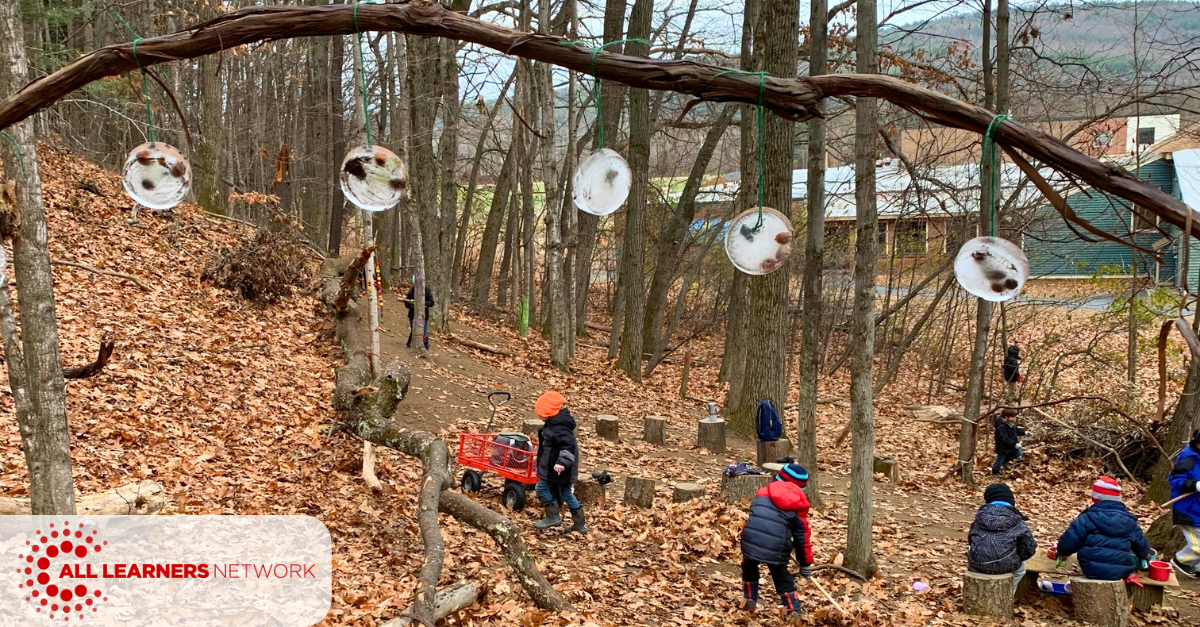
Discovering the Math in Our Outdoor Spaces
Published: February 7, 2025
Each school has its own unique outdoor play spaces–playgrounds, forests, open fields, sandy spaces, roof tops, city parks, gardens, grassy spaces, rolling hills–and there is a world of mathematics to be experienced and discovered in each kind of outdoor space. I was fortunate to teach at school with a forest classroom and that will be my point of view for this blog, but I encourage you to imagine the math awaiting you and your learners in your outdoor spaces as you read along. My aim is to share what math concepts we noticed our preschool and kindergarten learners tangling with during our time in the forest classroom and to make a case that more time spent outside is a great way to do more math.

Our “forest classroom” was little more than a forgotten wooded hillside right outside our classroom door, but that magical space was just the right size for us and offered many nooks and crannies for a variety of play. Over time, with requests and suggestions from the children, we carved out spaces for different kinds of play:
- Fort building
- Quiet spaces for animal observations
- Artistic and “musical” explorations
- A mud kitchen
- Gross Motor Play - with climbing and balancing spaces made up of fallen trees
- Fine Motor Play - small collections and small building materials
Each nook of our forest classroom was rich with intrinsic mathematical play opportunities:
- Fort Building & the Mud Kitchen - counting (one-to-one correspondence and cardinality), comparing size, length and quantity, measuring, sorting, classifying, and estimating
- Quiet Spaces - counting and comparing quantities (there are more chipmunks than squirrels today… how many more?), subitizing and counting objects we cannot touch or move
- Artistic and “musical” explorations spaces - spatial awareness, counting, ordering/sequencing, sorting and classifying, and patterning
- Gross Motor Play - counting, comparing, and estimating
- Fine Motor Play- sorting, organizing, classifying, ordering, comparing, estimating, counting, measuring, composing/decomposing quantities, and comparing
While at play in the outdoor classroom, the children were also practicing and refining what they were learning in indoor classrooms:
- Taking risks and trying new things
- Persevering when confronted with a problem
- Listening to each other
- Communicating and explaining their plans to each other
- Being open to other’s ideas
- Being patient when plans are not successful, at first
- Using tools safely and efficiently
- Using precise language to describe the attributes of an object

These types of “skills” are often referred to as soft skills or interpersonal skills, but they are also the foundation for the standards of mathematical practice. These essential skills take time to develop and refine and playing outdoors often creates an environment for optimal growth of these skills. There are challenges and risks in how we move around the space, the play is more open-ended and requires ongoing communication, not all plans work out at first, and perseverance is crucial. The children would often draw strength and encouragement from the challenges they confronted outside when faced with obstacles inside. We often referenced their outside “play struggles or tangles” during whole group conversations about perseverance and learning from our mistakes. The words struggle, hard, and tricky were positive words that we used to name their growth. Look what we built today…look what I know now.
In the early days of developing our forest classroom space, I was not really attending to the math our young children might tangle with. I was more concerned with their safety and learning routines for our time in the forest. Over time, as our preschoolers and kindergarteners became more confident and independent, I found I could step back and observe the intrinsic math at work while they were at work. I jotted down notes about their play, developing language/vocabulary, and their observations. I could visit with children while they played, ask questions, and collect important formative assessment information. I was able to use that information to plan “Forest Explorations”. These optional activities were enjoyed by most of the children and often served as a conversational bridge to the work we were doing inside.
Some of their favorite explorations were:
- Counting collections of acorns
- Trying to count the prolific (and seemingly fearless) chipmunks who called our forest classroom home. At first, this involved a system of adding 1 acorn to a bucket for every chipmunk spotted and evolved into using a clipboard and tally marks for collecting and comparing the chipmunk data over time
- Collecting and analyzing weather and seasonal data
- Creating same-sized sets of different objects and then using those sets of objects in their play, often in the mud kitchen or their fairy houses
- Playing games in a life-sized ten frame (the children were the game pieces in five or ten frames drawn with chalk or built with sticks)
- Building patterns with fallen leaves and other found objects in the forest
- Designing ice patterns (or ice designs) with found objects and patiently waiting until the next day to see if their pattern was still there or if the freezing of the water changed their design
- Building fairy houses and tiny bridges (for the fairies, insects, and chipmunks)
- Notice and Wonder chats - these might be about seasonal changes in the forest classroom we were noticing, comparing the length of a stick to other objects in the forest (find something that is the same length, shorter, longer), or a crowd favorite - What Changed? (A few objects were placed on a piece of fabric and 1 or 2 were removed while the children had their eyes closed.)
- Cooking - we were fortunate to have camp fires on Fridays that were run by parent volunteers and occasionally we cooked some delicious treats or made hot cocoa. We followed the steps in a recipe, measured ingredients, and kept track of time as items cooked
- Sugaring - We were very lucky that our outdoor classroom had several larger sugar maple trees that we tapped each spring. We collected sap (with help from some middle schoolers), and kept track of how many gallons we had until we had enough to boil and make some delicious maple syrup.
There is something uniquely wonderful about bringing a group of young learners outside. The hum of excitement can be keenly felt as they locate their hats, coats, and maybe even change into boots in anticipation of mud puddles. Having dressed for the weather and made some preliminary plans for play, they walk collectively toward the door barely containing their enthusiasm until finally they burst through with the frenetic energy of an erupting volcano. Running, skipping, and joyfully squealing their way towards the playground or an outdoor play space.
Once outside there is a tremendous variety of “work” to be done. For some children an immediate inspection of the play space is essential. Noticing what is new or what has been altered by the weather, animals, or other children and making plans for repair or new construction can take up much of their playtime. Some children need to find quieter spaces for building small structures or making observations of the birds and insects that have made their homes in the elements that make up outdoor play spaces. Others need to run, jump, and climb to discover how their balance strength has grown since we were last outside. In all these pursuits there lies mathematical sense making opportunities that are significant to the learner who encounters them. Important number sense landmarks that children deserve time to explore are also present. The children may not have gone in search of math games or activities, but nevertheless the math found them through their planning and play each time they entered the forest classroom.
There are various philosophical approaches to outdoor learning spaces and there is much to consider and plan for before spending lengthy periods of time outside. I have included some resources, below, that were invaluable as we designed our outdoor learning space, considered necessary routines, and how we might leverage our outdoor spaces for student growth, engagement, and joy. What is made clear from all that I have read is this… go outside and have fun!
ADDITIONAL RESOURCES
A Forest Days Handbook-Program Design for School Days Outside-Eliza Minnucci & Meghan Teachout (2018)
APA-Minnucci, E., & Teachout, M. (2018). A forest days handbook: Program design for school days outside. Green Writers Press.
Nature Preschools and Forest Kindergartens-The Handbook for Outdoor Learning-David Sobel (2016)
APA-Sobel, D. (2016). Nature preschools and forest kindergartens: The handbook for outdoor learning. Redleaf Press.
The Outdoor Classroom in Practice, Ages 3-7-A Month-by-Month Guide to Forest School Provision-Karen Constable (2018)
APA-Constable, K. (2018). The outdoor classroom in practice, ages 3–7: A month-by-month guide to forest school provision. Routledge.
Messy Maths-A Playful, Outdoor Approach for Early Years-Juliet Robertson (2017)
APA-Robertson, J. (2017). Messy maths: A playful, outdoor approach for early years. Crown House Publishing Ltd.
Play the Forest School Way-Woodland Games, Crafts and Skills for Adventurous Kids-Jane Worroll & Peter Houghton (2016)
APA-Worroll, Jane, and Peter Houghton. Play The Forest School Way: Woodland Games and Crafts for Adventurous Kids. Watkins Media Limited, 2016.
A Year of Forest School-Outdoor Play and Skill Building for Every Season-Jane Worroll & Peter Houghton (2018)
APA-Worroll, J., & Houghton, P. (2018). A year of forest school: Outdoor play and skill-building fun for every season. Watkins Media Limited.
Click here for the printable version.
What Now?
- Read our blog Finding Math Outside for more ways to incorporate math into outdoor activities.
- Check out why we recommend starting each math block with Launch and see how you can get your students to create Launches of their own.
- Bring All Learners Network (ALN) into your school or district for embedded professional development.

All Learners Network is committed to a new type of math instruction. We focus on supporting pedagogy so that all students can access quality math instruction. We do this through our online platform, free resources, events, and embedded professional development. Learn more about how we work with schools and districts here.





